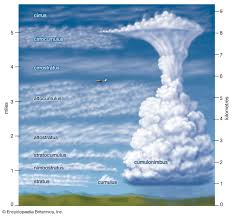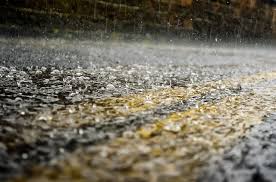Meaning, Formation, Types and Measurements of Precipitation
Precipitation is the primary input vector of the hydrologic cycle. It replenish both surface and groundwater sources. The major forms of precipitation are rain, snow and hail.
Precipitation is derived from atmospheric water, its form and quantity thus being influenced by the action of other climatic factors such as wind, temperature, and atmospheric pressure.
In this article, we shall attempt a definition of precipitation, its formation, types and measurement.
What is Precipitation?
Precipitation can be defined as water falling in solid or liquid form e.g. rain, snow, and hail. Precipitation is the process that provides the fresh water essential for most forms of terrestrial life. Clouds are the source of precipitation; however, evaporation and condensation processes are the driving forces.
Formation of Precipitation
Precipitation can form in two ways. In warm clouds, fine water droplets condense, collide, and coalesce into larger and larger droplets that can fall as rain. In colder clouds, ice crystals form and grow in a cloud that contains a mixture of both ice crystals and water droplets.
The first process occur when saturated air rises rapidly, and cooling forces additional condensation. Cloud droplets grow by added condensation and attain a diameter of 50 to 100mm. In collisions with one another; the droplets grow to about 500um in diameter. This is the size of water droplets in drizzle.
Further collisions and coalescence increase drop size and yield rain. Average rain drops have diameters of about 1000 to 2000um, but they can reach a maximum diameter of about 7000um. Above this value they become unstable and break into smaller drops while falling. This type of precipitation occurs in warm clouds typical of the equatorial and tropical zones.
In cold clouds, a second process produces snow. Here, clouds contain a mixture of ice crystals and super cooled water droplets. As the ice crystals take up water vapour and grow by deposition, the super cooled water droplets lose water vapour by evaporation and shrink.
When an ice crystal collides with a droplet of super cooled water, it induces freezing of the droplet. Ice crystals grow further, taking on shapes such as plates, columns, or needles. Under certain conditions, the ice crystals take the form of dendrites – delicate structure with six-sided symmetry.
When the underlying air layer is below freezing, snow reaches the ground as a solid form of precipitation. Otherwise, it melts and arrives as rain. A reverse process, the fall of raindrops through a cold air layer results in the freezing of rain and produces pellets or gains of ice; which are commonly referred to as a sleet in North America (Strahler and Strahler, 2006).
Types of Precipitation
Precipitation is often classified according to the factor mainly responsible for the lifting of the air mass (Linsley, et al, 1982). Accordingly, three major types of precipitation are identified. They include cyclonic, convectional and orographic precipitation.

1. Cyclonic Precipitation
Cyclonic precipitation results from the lifting of air converging into a low-pressure-area, or cyclone. Cyclonic precipitation may be either frontal or nonfrontal. Frontal precipitation results from the lifting of warm air on one side of a frontal surface over, cold denser air on the other side.
Warm-front precipitation is formed when warm air advances upward over a colder air mass. The rate of ascent is relatively slow, since the average slope of the frontal surface is usually between 1/100 and 1/300.
Precipitation may extend 300 to 500km ahead of the surface front and is generally light to moderate and nearly continues until passage of the front.
Cold front precipitation, on the other hand, is of showery nature and is formed when warm air is forced upward by an advancing mass of cold air, the leading edge of which is the surface cold front. Cold fronts move faster than warm fronts, and the frontal surfaces, with slopes usually averaging 1/50 to 1/150, is steeper.
Consequently, the warm air is forced upward more rapidly than by the warm front, and precipitation rates generally much higher. Heaviest amounts and intensities occur near the surface front.
2. Convectional Precipitation
Convectional precipitation is caused by natural rising of warmer, lighter air in colder, denser surrounding.
Generally, this kind of precipitation occurs in the topics, where on a hot day, the ground surface gets heated unequally, causing the warmer air to lift up as the colder air comes to take its place.
The vertical air currents develop tremendous velocities. Convectional precipitation occurs in the form of showers of high intensity and of short duration.
3. Orographic Precipitation
Orographic precipitation is caused by air masses which strike some natural topographic barriers like mountains, and cannot move forward and hence rise up, causing condensation and precipitation. All the precipitation we have in Himalayan region is because of this nature. It is rich in moisture because of their long travel over oceans.
At this point, it should be noted that in nature, the effects of these various types of cooling discussed above, are often interrelated. Therefore, the resulting precipitation in most cases cannot be identified as being of any one type.
Measurement of Precipitation
A variety of instruments and techniques have been developed for gathering information on precipitation. Instruments for measuring amount and intensity of precipitation are the most important.
All forms of precipitation are measured on the basis of the vertical depth of water that would accumulate in a level surface if the precipitation remained where it fell. In the metric system precipitation is measured in millimeters and tenths.
Precipitation is measured with a rain gauge. It consists of a collecting jar, a funnel and a container, which is dug on the ground, with 30cm of the instrument appearing above the ground.
Rain gauge is usually sited is an open place, where there are no trees or tall buildings to obstruct the incoming precipitation. The diameter of the funnel is normally 13cm. The water that collects in the jar is then poured into a measurement cylinder from where the amount of precipitation that has fallen is read off.
In summary, precipitation is an important process of the hydrologic cycle, which helps to replenish both surface and groundwater sources. It also helps to sustain the available freshwater pool on earth.
Read Also : Methods of Disposal of Waste Pesticide Containers
Having gone through this article, you should appreciate the various dynamic processes that take place for us to receive precipitation on planet Earth. In addition, you should be well acquainted with the types of precipitation and mode of its measurement.
Precipitation can be defined as water falling in solid or liquid form e.g. rain, snow, and hail. The formation of precipitation involves three basic processes-lifting and cooling of air mass, condensation and droplet formation.
There are three types of precipitation – cyclonic, convectional and orographic. Rain gauge is an instrument used in measuring precipitation.



